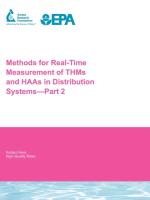- Start
- Methods for Real-Time Measurement of Thms and Haas in Distribution Systems - Part 2
Methods for Real-Time Measurement of Thms and Haas in Distribution Systems - Part 2
Angebote / Angebote:
Chlorine, typically applied as gaseous chlorine, sodium hypochlorite, or calcium hypochlorite, is a safe and economical water disinfectant and has been used with great success for over a century. Unfortunately, water chlorination results in the formation of halogenated disinfection by-products (DBPs), including trihalomethanes (THMs) and haloacetic acids (HAAs). Maximum contaminant levels (MCL) have been established by the USEPA for drinking water due to the possible adverse health effects from ingestion of THMs and HAAs. The current MCLs for total THMs and total HAAs in drinking water are 0.080 mg/L and 0.060 mg/L, respectively. Future regulations might lower the MCL for these DBPs, requiring plant operators to minimize total THMs and total HAAs concentrations in drinking water. To accomplish these goals, analytical methods are needed that will provide monitoring data in real-time or near real-time.
The overall goal of this research was to develop chemical analyzers and associated analytical methods for online monitoring of THM and HAA concentrations directly from drinking water distribution systems.
The project has led to the development of several alternative analyzers for real-time monitoring of THMs and HAAs. The details of the construction and operation of the three most promising analyzers are provided. These three analyzers, operated in concert or separately, provide water utilities with relatively low cost simple alternatives for optimizing treatment practices with the possibility of minimizing the formation of THMs and HAAs.
Folgt in ca. 15 Arbeitstagen

